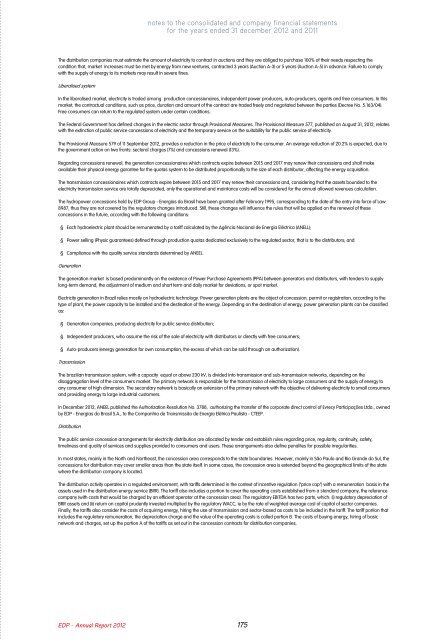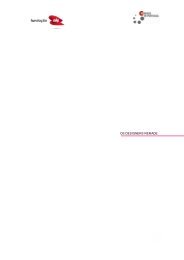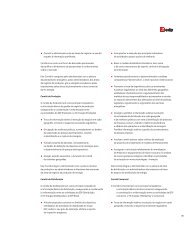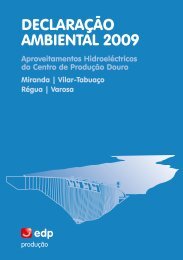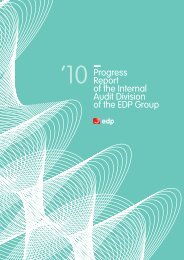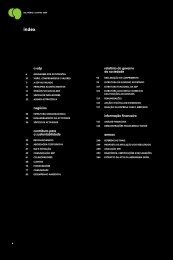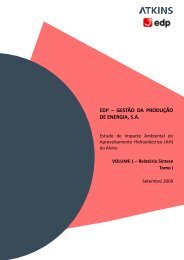notes to the <strong>EDP</strong> consolidated - Energias de Portugal, and company S.A. financial statementsNotes to for the the Consolidated years and ended Company 31 december Financial Statements 2012 and 2011for the years ended 31 December 2012 and 2011The distribution companies must estimate the amount of electricity to contract in auctions and they are obliged to purchase 100% of their needs respecting thecondition that, market increases must be met by energy from new ventures, contracted 3 years (Auction A-3) or 5 years (Auction A-5) in advance. Failure to complywith the supply of energy to its markets may result in severe fines.Liberalised systemIn the liberalised market, electricity is traded among production concessionaires, independent power producers, auto-producers, agents and free consumers. In thismarket, the contractual conditions, such as price, duration and amount of the contract are traded freely and negotiated between the parties (Decree No. 5.163/04).Free consumers can return to the regulated system under certain conditions.The Federal Government has defined changes in the electric sector through Provisional Measures. The Provisional Measure 577, published on August 31, 2012, relateswith the extinction of public service concessions of electricity and the temporary service on the suitability for the public service of electricity.The Provisional Measure 579 of 11 September 2012, provides a reduction in the price of electricity to the consumer. An average reduction of 20.2% is expected, due tothe government action on two fronts: sectoral charges (7%) and concessions renewal (13%).Regarding concessions renewal, the generation concessionaires which contracts expire between 2015 and 2017 may renew their concessions and shall makeavailable their physical energy garantee for the quotas system to be distributed proportionally to the size of each distributor, affecting the energy acquisition.The transmission concessionaires which contracts expire between 2015 and 2017 may renew their concessions and, considering that the assets bounded to theelectricity transmission service are totally depreciated, only the operational and maintance costs will be considered for the annual allowed revenues calculation.The hydropower concessions held by <strong>EDP</strong> Group - Energias do Brasil have been granted after February 1995, corresponding to the date of the entry into force of Law8987, thus they are not covered by the regulatory changes introduced. Still, these changes will influence the rules that will be applied on the renewal of theseconcessions in the future, according with the following conditions:§§§Each hydroelectric plant should be remunerated by a tariff calculated by the Agência Nacional de Energia Eléctrica (ANELL);Power selling (Physic guarantees) defined through production quotas dedicated exclusively to the regulated sector, that is to the distributors; andCompliance with the quality service standards determined by ANEEL.GenerationThe generation market is based predominantly on the existence of Power Purchase Agreements (PPA) between generators and distributors, with tenders to supplylong-term demand, the adjustment of medium and short term and daily market for deviations, or spot market.Electricity generation in Brazil relies mostly on hydroelectric technology. Power generation plants are the object of concession, permit or registration, according to thetype of plant, the power capacity to be installed and the destination of the energy. Depending on the destination of energy, power generation plants can be classifiedas:§Generation companies, producing electricity for public service distribution;§ Independent producers, who assume the risk of the sale of electricity with distributors or directly with free consumers;§ Auto-producers (energy generation for own consumption, the excess of which can be sold through an authorization).TransmissionThe brazilian transmission system, with a capacity equal or above 230 kV, is divided into transmission and sub-transmission networks, depending on thedisaggregation level of the consumers market. The primary network is responsible for the transmission of electricity to large consumers and the supply of energy toany consumer of high dimension. The secondary network is basically an extension of the primary network with the objective of delivering electricity to small consumersand providing energy to large industrial customers.In December 2012, ANEEL published the Authorization Resolution No. 3788, authorizing the transfer of the corporate direct control of Evrecy Participações Ltda., ownedby <strong>EDP</strong> - Energias do Brasil S.A., to the Companhia de Transmissão de Energia Elétrica Paulista - CTEEP.DistributionThe public service concession arrangements for electricity distribution are allocated by tender and establish rules regarding price, regularity, continuity, safety,timeliness and quality of services and supplies provided to consumers and users. These arrangements also define penalties for possible irregularities.In most states, mainly in the North and Northeast, the concession area corresponds to the state boundaries. However, mainly in São Paulo and Rio Grande do Sul, theconcessions for distribution may cover smaller areas than the state itself. In same cases, the concession area is extended beyond the geographical limits of the statewhere the distribution company is located.The distribution activity operates in a regulated environment, with tariffs determined in the context of incentive regulation ("price cap") with a remuneration basis in theassets used in the distribution energy service (BRR). The tariff also includes a portion to cover the operating costs established from a standard company, the referencecompany (with costs that would be charged by an efficient operator at the concession area). The regulatory EBITDA has two parts, which: (i) regulatory depreciation ofBRR assets and (ii) return on capital prudently invested multiplied by the regulatory WACC, ie by the rate of weighted average cost of capital of sector companies.Finally, the tariffs also consider the costs of acquiring energy, hiring the use of transmission and sector-based as costs to be included in the tariff. The tariff portion thatincludes the regulatory remuneration, the depreciation charge and the value of the operating costs is called portion B. The costs of buying energy, hiring of basicnetwork and charges, set up the portion A of the tariffs as set out in the concession contracts for distribution companies.<strong>EDP</strong> - <strong>Annual</strong> <strong>Report</strong> 2012175
notes to the consolidated and company financial statements<strong>EDP</strong> - Energias Portugal, S.A.for the years ended 31 december 2012 and 2011Notes to the Consolidated and Company Financial Statementsfor the years ended 31 December 2012 and 2011Tariffs are adjusted annually based on changes in portion A costs and in the monetary correction of portion B costs, by the index of variation of IGPM (Market pricesindex), discounted of productivity gains (factor X). Periodically (on average every 4 years), a Periodic Tariff Review occurs, generating the recalculation of all costs, thedefinition of a new BRR and a new reference company, capturing productivity gains occured in the period between revisions. In the beginning of 2010 an addendumto the concession contracts of distribution companies was signed to ensure the neutrality of sector costs.SupplyThe electricity suppliers that do not own electric assets, are authorised to act exclusively in the free market, selling or buying energy in quantity, conditions and pricesfreely negotiated. The commercialization of energy with a distributor is only possible through participation in the "Auction set by the distributors", with the negotiationof contracts, for a maximum of two years, and commencement of energy delivery within a period not exceeding two years.Public Domain AssetsIn Brazil, fixed assets used in the distribution and the supply activities are binded to these services and cannot be removed, sold, transferred or mortgaged without theprior and express consent of the regulator (ANEEL).Activity in the Renewable Energies SectorIn December 2007 the <strong>EDP</strong> Group incorporated <strong>EDP</strong> Renováveis, S.L. in Spain so as to concentrate the Group's subsidiaries in the renewable energies sector. At 18March 2008, <strong>EDP</strong> Renováveis was converted into a public limited company.On 4 July 2008, a share capital increase of <strong>EDP</strong> Renováveis was made through an Initial Public Offering (IPO) of 196,024,306 shares. This share capital increase wasnot subscribed by the <strong>EDP</strong> Group, resulting in a dilution of the interest held in <strong>EDP</strong> Renováveis from 100% to 77.53%. The share capital increase amounted to 1,566,726thousands of Euros, of which 980,121 thousands of Euros relates to the capital increase and 586,605 thousands of Euros relates to the share premium.ElectricityGenerationIn December 2012, <strong>EDP</strong> Renováveis, the subsidiary of <strong>EDP</strong> Group for the renewable energies sector, holds the share capital of <strong>EDP</strong> Renewables Europe, S.L. (<strong>EDP</strong>R EU,previous designated as Nuevas Energias del Ocidente, S.L), <strong>EDP</strong> Renewables North America , L.L.C. (<strong>EDP</strong>R NA, previous designated as Horizon Wind Energy, L.L.C. ) and<strong>EDP</strong> Renováveis Brasil, S.A., operating respectively in Europe, in the United States of America and in Brazil.<strong>EDP</strong> Renewables Europe operates through its subsidiaries located in Portugal, Spain, France, Belgium, Poland, Romania, Italy and United Kingdom. <strong>EDP</strong>R EU's mainsubsidiaries are: <strong>EDP</strong> Renováveis Portugal, <strong>EDP</strong> Renewables España, <strong>EDP</strong> Renewables France, Greenwind (Belgium), <strong>EDP</strong> Renewables Polska, <strong>EDP</strong> RenewablesRomania, <strong>EDP</strong> Renewables Italia. As at 31 December 2012, Spain and Portugal are the most relevant geographical markets where <strong>EDP</strong>R EU operates.In July 2007 the <strong>EDP</strong> Group acquired from Goldman Sachs, 100% of the share capital of <strong>EDP</strong>R NA, which develops, manages and operates wind farms in the UnitedStates of America. <strong>EDP</strong>R NA holds a series of wind farms in operation and a pipeline of projects under development for the construction of wind farms.Regulatory framework for the activities in SpainThe Electrical Sector in Spain is regulated by Law 54 of 27 November 1997 and the subsequent amendments to legislation. In May 2007, the Spanish Governmentapproved the Royal Decree (RD 661/2007) which implemented the new regulatory framework for wind energy installations to be built from 2008 to 2012, which will beapplicable for all operating assets from 31 December 2012.According to RD 661/2007, wind farms are entitled to choose between two remuneration schemes: (i) Fixed tariff and (ii) market plus premium: wind farms receive foreach hour the pool price plus a variable premium. Once the decision between the two schemes has been made for a specific wind farm, it is binding for, at least, oneyear. Wind farms installed before January 2008 are ruled by the transitory regime, established by Decree 436/2004. Under this transitory regime, that ended inDecember 2012, wind farms could choose between a fixed tariff and a market option receiving market price plus a fixed premium.In July 2010, the Ministry of Industry established an agrement with two major associations of renewable energy (Spanish Wind Energy Association and Protermosolar)to change the existing regulation. This agreement resulted in the approval of Royal Decree 1614/2010, of December 7, which defines (i) for the years 2011 and 2012 areduction of 35% in the income applicable to wind generation defined by Royal Decree 661/2007, (ii) an addendum to article 44.3 of Royal Decree 661/2007 clarifyingthat future revisions of the income for energy production through renewable sources will only be applied to the installed capacity from 2012 and (iii) the definition of alimit of 2,589 hours of operation for the installed capacity.On 28 January 2012 the Spanish Government enacted Royal-Decree Law 1/2012 that approves a temporary suspension of the remuneration for renewable energycapacity not included in the pre-assignation registry.In December 2012, through the Law 15/2012 of 27 December, the Spanish Government approved a 7% across-the-board tax on electricity generation. The tax will beapplied from 1 January 2013 onwards.Regulatory framework for the activities in PortugalThe Portuguese legal provisions applicable to the generation of electrical power based on renewable resources are currently established by Decree-Law No. 189/88dated 27 May, as amended by Decree-Law No. 168/99 dated 18 May, Decree-Law No. 312/2001 dated 10 December and Decree-Law No. 339-C/2001 dated 29December. Also relevant is Decree-Law No. 33-A/2005, dated 16 February, which establishes the current values used in the remuneration formula applicable toenergy produced by means of renewable resources and the deadlines for the application of such remuneration formula.176A World Full Of Energy
- Page 1:
Impresso em papel elaborado com cel
- Page 6 and 7:
: edp :index6 edp6 message to share
- Page 8 and 9:
: edp :EDP - Annual Report 20127
- Page 10 and 11:
Portugalrenewablesgás7,194 Employe
- Page 12 and 13:
: edp :1.1.3. CORPORATEBODIESboard
- Page 14 and 15:
: edp :1.1.5. principles ofsustaina
- Page 16 and 17:
: edp :BRAzILEDP Brasil distinguish
- Page 18 and 19:
: edp :1.3.2. Operating HighlightsU
- Page 20:
: edp :1.3.5. ENVIRONMENT INDICATOR
- Page 24 and 25:
: edp :strategicframeworkxxxxxxxxxx
- Page 26 and 27:
: strategic framework :Reconversion
- Page 28 and 29:
: strategic framework :EVOLUTION OF
- Page 30 and 31:
: strategic framework :million at D
- Page 32 and 33:
: strategic framework :Since 2005,
- Page 34:
: strategic framework :EDP - Annual
- Page 38 and 39:
: a edp :performance38 business40 I
- Page 40 and 41:
: performance :EDP - Annual Report
- Page 42 and 43:
: performance :By the end of the ye
- Page 44 and 45:
: performance :electricity generati
- Page 46 and 47:
: performance :EDP Distribuição h
- Page 48 and 49:
: performance :electricity AND GAS
- Page 50 and 51:
: performance :Despite the increase
- Page 52 and 53:
: performance :electricity supply i
- Page 54 and 55:
: performance :In 2012, EDPR increa
- Page 56 and 57:
: performance :3.1.3. EDP BRAsILEDP
- Page 58 and 59:
: performance :EDP brasilGENERATION
- Page 60 and 61:
: performance :Distribution of comp
- Page 62 and 63:
: performance :testing the adherenc
- Page 64 and 65:
: performance :3.4.1. managementsys
- Page 66 and 67:
: performance :In Brazil, EDP has n
- Page 68 and 69:
: performance :that 117 m 3 of oil
- Page 70 and 71:
: performance :EDP has undertaken t
- Page 72 and 73:
: performance :encourages professio
- Page 74 and 75:
: performance :The set of indicator
- Page 76 and 77:
: performance :Voice of the custome
- Page 78 and 79:
: performance :(ACAPO), are also av
- Page 80 and 81:
: performance :3.7. suppliersThe pe
- Page 82 and 83:
: performance :Transparency; Leader
- Page 84 and 85:
: performance :The following table
- Page 86:
: performance :between the local au
- Page 90 and 91:
: a edp :Corporate governance89 sta
- Page 92 and 93:
: corporate governance :STATEMENT O
- Page 94 and 95:
: corporate governance :STATEMENT O
- Page 96 and 97:
: corporate governance :I. GENERALM
- Page 98 and 99:
: corporate governance :In all othe
- Page 100 and 101:
: corporate governance :II.1.1. Cor
- Page 102 and 103:
: corporate governance :The company
- Page 104 and 105:
: corporate governance :Strategy Co
- Page 106 and 107:
: corporate governance :Companies C
- Page 108 and 109:
: corporate governance :From 22 Feb
- Page 110 and 111:
: corporate governance :The Institu
- Page 112 and 113:
: corporate governance :Careers, Mo
- Page 114 and 115:
: corporate governance :Commercial
- Page 116 and 117:
: corporate governance :Corporate S
- Page 118 and 119:
: corporate governance :new matters
- Page 120 and 121:
: corporate governance :with the Eu
- Page 122 and 123:
: corporate governance :unavailabil
- Page 124 and 125:
: corporate governance :in share ca
- Page 126 and 127: : corporate governance :II.19. Posi
- Page 128 and 129: : corporate governance :II.26. Rule
- Page 130 and 131: : corporate governance :II.28. Posi
- Page 132 and 133: : corporate governance :Executive B
- Page 134 and 135: : corporate governance :EDP has no
- Page 136 and 137: : corporate governance :CHAPTER III
- Page 138 and 139: : corporate governance :III.3. Hold
- Page 140 and 141: : corporate governance :Share price
- Page 142 and 143: : corporate governance :Capital Mar
- Page 144 and 145: : corporate governance :III.13. Int
- Page 146 and 147: : corporate governance :In 2012, th
- Page 151 and 152: EDP Renováveis opensfirst wind far
- Page 153 and 154: : financial report :5.1. edp group
- Page 155 and 156: : financial report :these impacts,
- Page 157 and 158: : financial report :local currency,
- Page 159 and 160: : financial report :amount of EUR 1
- Page 161 and 162: : financial report :EDP - Energias
- Page 163 and 164: : financial report :EDP - Energias
- Page 165 and 166: : financial report :EDP - Energias
- Page 167 and 168: : financial report :EDP - Energias
- Page 169 and 170: : financial report :EDP - Energias
- Page 171 and 172: 12.pdf 1 02/04/13 14:50notes to the
- Page 173 and 174: notes to the consolidated EDP and -
- Page 175: notes to the consolidated EDP and -
- Page 179 and 180: notes to the consolidated EDP and -
- Page 181 and 182: notes to the consolidated EDP and -
- Page 183 and 184: notes to the consolidated EDP and -
- Page 185 and 186: notes to the consolidated EDP and -
- Page 187 and 188: notes to the consolidated EDP and -
- Page 189 and 190: notes to the consolidated EDP and -
- Page 191 and 192: notes to the consolidated EDP and -
- Page 193 and 194: notes to the consolidated EDP - and
- Page 195 and 196: notes to the consolidated EDP and -
- Page 197 and 198: notes to the consolidated EDP - and
- Page 199 and 200: notes to the consolidated EDP - and
- Page 201 and 202: notes to the consolidated EDP - and
- Page 203 and 204: notes to the consolidated EDP and -
- Page 205 and 206: notes to the consolidated EDP - and
- Page 207 and 208: notes to the consolidated EDP - and
- Page 209 and 210: notes to the consolidated and compa
- Page 211 and 212: notes to the consolidated EDP - and
- Page 213 and 214: notes to the consolidated EDP - and
- Page 215 and 216: notes to the consolidated EDP - and
- Page 217 and 218: notes to the consolidated EDP - and
- Page 219 and 220: notes to the consolidated EDP and -
- Page 221 and 222: notes to the consolidated EDP and -
- Page 223 and 224: notes to the consolidated EDP - and
- Page 225 and 226: notes to the consolidated EDP - and
- Page 227 and 228:
notes to the consolidated EDP - and
- Page 229 and 230:
notes to the consolidated EDP - and
- Page 231 and 232:
notes to the consolidated EDP and -
- Page 233 and 234:
notes to the consolidated EDP - and
- Page 235 and 236:
notes to the consolidated EDP and -
- Page 237 and 238:
notes to the consolidated EDP - and
- Page 239 and 240:
notes to the consolidated EDP - and
- Page 241 and 242:
notes to the consolidated EDP - and
- Page 243 and 244:
notes to the consolidated EDP - and
- Page 245 and 246:
EDP - Energias de Portugal, S.A.Not
- Page 247 and 248:
notes to the consolidated EDP - and
- Page 249 and 250:
notes to the consolidated EDP and -
- Page 251 and 252:
notes to the consolidatedEDPand- En
- Page 253 and 254:
notes to the consolidated EDP - and
- Page 255 and 256:
notes to the consolidated EDP and -
- Page 257 and 258:
notes to the consolidated and compa
- Page 259 and 260:
notes to the consolidated and compa
- Page 261 and 262:
notes to the consolidated and compa
- Page 263 and 264:
notes to the consolidated and compa
- Page 265 and 266:
notes to the consolidated and compa
- Page 269 and 270:
Hydroelectric powerplant of Bempost
- Page 271 and 272:
: annexes :annexesannex Ifinal refe
- Page 273 and 274:
: annexes :by Instituto Superior de
- Page 275 and 276:
: annexes :Chairman of Euronext Lis
- Page 277 and 278:
: annexes :basis. He was designated
- Page 279 and 280:
: annexes :annex IIItransactions pe
- Page 281 and 282:
: annexes :EDP’s material issues
- Page 283 and 284:
: annexes :Simultaneously, the foll
- Page 285 and 286:
: annexes :GRI complianceThis repor
- Page 287 and 288:
: annexes :286A World Full Of Energ
- Page 289 and 290:
: annexes :288A World Full Of Energ
- Page 291 and 292:
: annexes :290A World Full Of Energ
- Page 293 and 294:
: annexes :292A World Full Of Energ
- Page 295 and 296:
: annexes :294A World Full Of Energ
- Page 297 and 298:
: annexes :296A World Full Of Energ
- Page 299 and 300:
: annexes :298A World Full Of Energ
- Page 301 and 302:
: annexes :300A World Full Of Energ
- Page 303 and 304:
: annexes :302A World Full Of Energ
- Page 305 and 306:
: annexes :304A World Full Of Energ


